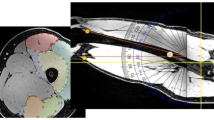Summary
Muscle cross-section areas were measured by magnetic resonance imaging (MRI) in the thigh of a human cadaver,. the results being compared with those obtained by photography of corresponding anatomic macroslices. A close correlation was found between MRI and photographic evaluation, differences between the methods ranging from nil to 9.5%, depending on the scan position and the muscle groups. In vivo MRI measurements were performed on 12 female and 16 male students, the objectivity, the test-retest reliability and the variability of the MRI measurements being studied by fixing the scan position either manually or by coronary scan. The latter method appeared to be more objective and reliable. The coefficients of variation for muscle cross-section areas measured by MRI were in the range of those for the planimetry of given cross-section areas. Allowing for differentiation between several small muscle bundles in a given area, MRI proved to be a suitable method to quantify muscle cross-sections for intra- and interindividual analysis of muscle size.
Similar content being viewed by others
References
Beneke R (1988) Die Computertomographie als Verfahren der Muskeldiagnostik unter besonderer Berücksichtigung der motorischen Hauptbeanspruchungsform Kraft. Thesis, University of Cologne, Cologne
Beneke R, Brüggemann GP, Bohndorf K, Ritzdorf W, Hollmann W (1990) Die Bedeutung der Computertomographie in der Muskelkraftdiagnostik. Dtsch Z Sportmed 41:160–168
Bohndorf K, Reiser M, Lochner B, Feaux de Lacroix W, Steinbrich W (1986) Magnetic resonance imaging of primary tumors and tumor-like lesions of bone. Skeletal Radiol 15:511–517
Bohndorf K, Reiser M, Friedmann G, Ghussen F, Holzmüller W, Steinbrich W, Beyer D (1987) Wert der Kernspintomographie vor chirurgischer Therapie und Radiatio peripherer Weichteiltumoren. Fortschr Röntgenstr 146:130–136
de Koenig FL, Binkhorst RA, Kauer JMG, Thijssen HOM (1986) Accuracy of an anthropometric estimate of the muscle and bone area in a transversal cross-section of the arm. Int J Sports Med 7:246–249
Ehman RL, Berquist TH, McLeod RA (1988) MR imaging of the musculoskeletal system: a 5-year appraisal. Radiology 166:313–320
Franke F (1920) Die Kraftkurven menschlicher Muskeln bei willkürlicher Innervation und Frage der absoluten Muskelkraft. Pflügers Arch 184:300–323
Fukunaga T (1976) Die absolute Muskelkraft und das Muskelkrafttraining. Dtsch Z Sportmed 27:255–266
Haeggmark T, Jansson E, Svane B (1978) Cross-sectional area of the thigh muscle in man measured by computed tomography. Scand J Clin Lab Invest 38:355–360
Häkkinen K, Keskinen KL (1989) Muscle cross-sectional area and voluntary force production characteristics in elite strengthand endurance-trained athletes and sprinters. Eur J Appl Physiol 59:215–220
Henke W (1865) Die Größe der absoluten Muskelkraft aus Versuchen neu berechnet. Z Rat Med 3:247
Hermann L (1898) Zur Messung der Muskelkraft am Menschen. Pflügers Arch 73:429–437
Hicks JE, Shawker TH, Jones BL, Linzer M, Gerber LH (1984) Diagnostic ultrasound: its use in the evaluation of muscle. Arch Phys Med Rehabil 65:129–131
Hinshaw WS, Andrew ER, Bottomley PA, Holland GN, Moore WS, Worthington BS (1979) An in vivo study of the forearm and hand by thin section NMR imaging. Br J Radiol 52:36–43
Hudasch G, Albright JP, McAuley E, Martin RK, Fulton M (1985) Cross-sectional thigh components: computerized tomographic assessment. Med Sci Sports Exerc 17:417–421
Ikai M, Fukunaga T (1968) Calculation of muscle strength per cross-sectional area of human muscle by means of ultrasonic measurement. Int Z Angew Physiol 26:26–32
Ikai M, Fukunaga T (1970) A study on training effect on strength per unit cross-sectional area of muscle by means of ultrasonic measurement. Int Z Angew Physiol 28:173–180
Koster W (1867) Die absolute Muskelkraft. Nederlandsch Archief voor Geneeskunde Naturkunde (Selbstreferat im Centralbl Med Wiss) 3:423–424
Maughan RJ, Watson JS, Weir J (1983) Relationships between muscle strength and muscle cross-sectional area in male sprinters and endurance runners. Eur J Appl Physiol 50:309–318
Miller DI, Nelson RC (1976) Biomechanics of Sport. Lea & Febiger, Philadelphia
Morris CD (1948) The measurement of the strength of muscle relative to the cross-section. Res Quart 19:295–303
Narici MV, Roi GS, Landoni L (1988) Force of knee extensor and flexor muscles and cross-sectional area determined by nuclear magnetic resonance imaging. Eur J Appl Physiol 57:39–44
Narici MV, Roi GS, Landoni L, Minetti AE, Cerretelli P (1989) Changes in force, cross-sectional area and neural activation during strength training and detraining of the human quadriceps. Eur J Appl Physiol 59:310–319
Ramm B, Semmler W, Laniado M (1986) Einführung in die MR-Tomographie: Grundlagen und klinische Anwendung. Stuttgart
Rodiek SO (1987) CT, MR-Tomographie and MR-Spectroskopie bei neuromuskulären Erkrankungen. Enke Verlag, Stuttgart:34–59
Saziorski WM, Aruin AS, Selujanow WN (1984) Biomechanik des menschlichen Bewegungsapparates. Sportverlag, Berlin
Smith FW, Adam AH, Phillips WDP (1983) NMR imaging in pregnancy. Letter to the editor Lancet 1:61–62
Stark DD, McCarthy SM, Filly RA, Parer JT, Hricak H, Callen PW (1985) Pelvimetry by Magnetic Resonance Imaging. Amer J Roentgenol 44:947–950
Stoboy H (1984) Das Krafttraining und seine Beziehung zu verschiedenen Sportarten. Sportwissenschaft 14:9–31
Weinreb JC, Lowe ThW, Santos-Ramos R, Cunningham FG, Parkey R (1985) Magnetic resonance imaging in obstetric diagnosis. Radiology 154:157–161
Woltering H, Frohberger U, Mathiaß HH (1987) Muskelquerschnittsmessungen mittels Impulsechosonographie. Dtsch Z Sportmed 38:100–107
Young A, Hughes I (1982) Ultrasonography of muscle in physiotherapeutic practice and research. Physiotherapy 68:187
Young A, Stokes M, Walker ICR, Newham D (1981) The relationship between quadriceps size and strength in normal young adults. Ann Rheum Dis 40:619–620
Young A, Stokes M, Round JM, Edwards RHT (1983) The effect of high-resistance training on the strength and cross-section area of the human quadriceps. Eur J Clin Invest 13:411–417
Young A, Stokes M, Crowe M (1984) Size and strength of the quadriceps muscles of old and young women. Eur J Clin Invest 14:282–287
Author information
Authors and Affiliations
Rights and permissions
About this article
Cite this article
Beneke, R., Neuerburg, J. & Bohndorf, K. Muscle cross-section measurement by magnetic resonance imaging. Europ. J. Appl. Physiol. 63, 424–429 (1991). https://doi.org/10.1007/BF00868073
Accepted:
Issue Date:
DOI: https://doi.org/10.1007/BF00868073




